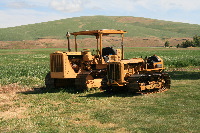- Posts: 1473
- Thank you received: 0

ACMOC Membership Benefits
- FREE quarterly magazine filled with content about antique Caterpillar machines
- FREE classified listings
- ACMOC store discounts and specials
- Full Bulletin Board Access
- Marketplace (For Sale/Wanted)
- Technical Library
- Post attachments
$44 /year ELECTRONIC
$60 /year USA
$77 /year International
D6 PTO speed
- mrsmackpaul
-

- Offline
- Platinum Boarder
- User
The hydraulic breakaway couplings appear to be back to front if the draw bar pin fell out it looks like there is no way for the hoses to let go or maybe they are different types of fittings than what Im used to
just wondering
a very neat job there of the pump install
Paul
Please Log in or Create an account to join the conversation.
I have never had this happen so I really have no experience. However, both my cats that have hydraulics are wired so that the hoses get get hooked up correctly, ie: one each way.
9U(2), 5J, IHC544, Ford860
Please Log in or Create an account to join the conversation.
In order to get a PTO out of a CAT takes an adapter specific for that purpose.
From Wiki
Technical standardization
Agricultural PTOs are standardized in dimensions and speed. The ISO standard for PTOs is ISO 500, which as of the 2004 edition was split into three parts:
ISO 500-1 General specifications, safety requirements, dimensions for master shield and clearance zone
ISO 500-2 Narrow-track tractors, dimensions for master shield and clearance zone
ISO 500-3 Main PTO dimensions and spline dimensions, location of PTO.
The original type calls for operation at 540 revolutions per minute (RPM). A shaft that rotates at 540 rpm has 6 splines on it, and a diameter of 1⅜". Two newer types, supporting higher power applications, operate at 1000 RPM and differ in shaft size. The larger shaft has 20 splines (1¾" diameter), while the smaller has 21 (1⅜" diameter). All three types rotate counterclockwise when viewed from the tractor (When standing behind the tractor, the shaft turns clockwise). A 10 spline type was used with some early equipment such as the 1948 Land Rover, a six spline adapter was usually supplied. It is customary for agricultural machines manufacturers to provide the nominal PTO power specification, an indication of the available instantaneous power at the shaft.
The first industry standard for PTO design was adopted by ASAE (the American Society of Agricultural Engineers) in April 1927. The PTO rotational speed was specified as 536 ± 10 rpm; the direction was clockwise. The speed was later changed to 540 rpm.[7]
9U(2), 5J, IHC544, Ford860
Please Log in or Create an account to join the conversation.
not been picky but I have question
The hydraulic breakaway couplings appear to be back to front if the draw bar pin fell out it looks like there is no way for the hoses to let go or maybe they are different types of fittings than what Im used to
just wondering
a very neat job there of the pump install
Paul
You are right. Those couplings are threaded together, so if the drawbar pin did happen to come out I would pull the hoses apart. My drawbar hole is built up and the triangle pin retainer works properly. The couplings are stucci (spelling might be wrong) they have the best flow rate for -12 coupler. I tried the cheaper pull apart ones but they can't handle the hydraulic flow I was putting though them. I would cook the relief valve in a couple hours of steady use. Since I was changing the hyd. Setup anyway the control valve I used has a detent on one spool to return the ejector and close the apron so I don't have to hold the handle the whole time.
Twenty L590. Thirty PS8863. RD6 2h1517. #10 Autopatrol 2K701
#11 Autopatrol 6k611. #11 Autopatrol 9F. #12 8T12832. #12 8T19829 #40 Scraper 1w5325. D2 5U4030. D4 7U 22120. D6 9U11633SP.
2 D311 gensets
Please Log in or Create an account to join the conversation.
- mrsmackpaul
-

- Offline
- Platinum Boarder
- User
- Posts: 1473
- Thank you received: 0
Paul, I dont think it makes a difference as I understand it is just the pull on the connection.
I have never had this happen so I really have no experience. However, both my cats that have hydraulics are wired so that the hoses get get hooked up correctly, ie: one each way.
With the break aways I have used and still use the knurled piece you pull or push with your hand when coupling or uncoupling has to be gripped otherwise they wont break away because there is nothing there too hold the knurled piece like your hand when uncoupling most have clamp that goes around those knurled pieces and that clamps to the tractor to work the breakaway
I have found when using the laser scoop because it corrects it self 5 - 10 times a second the couplings un hook them selves so I dont use the clamp but if I break something and the scoop parts way Im make one heck of a mess to everything
Paul
Please Log in or Create an account to join the conversation.
With the break aways I have used and still use the knurled piece you pull or push with your hand when coupling or uncoupling has to be gripped otherwise they wont break away because there is nothing there too hold the knurled piece like your hand when uncoupling most have clamp that goes around those knurled pieces and that clamps to the tractor to work the breakaway
I have found when using the laser scoop because it corrects it self 5 - 10 times a second the couplings un hook them selves so I dont use the clamp but if I break something and the scoop parts way Im make one heck of a mess to everything
Paul
Aha, thanks Paul, that is the answer. But I still don't understand on second thought. The knurled piece has to be slide toward it's own base so how is it hooked up? I am not next to my tractors right now but will be in a couple of weeks and I've gotta look this over to understand.
Or wait, does that knurled knob slide both directions??
9U(2), 5J, IHC544, Ford860
Please Log in or Create an account to join the conversation.
Twenty L590. Thirty PS8863. RD6 2h1517. #10 Autopatrol 2K701
#11 Autopatrol 6k611. #11 Autopatrol 9F. #12 8T12832. #12 8T19829 #40 Scraper 1w5325. D2 5U4030. D4 7U 22120. D6 9U11633SP.
2 D311 gensets
Please Log in or Create an account to join the conversation.
Bert
Twenty L590. Thirty PS8863. RD6 2h1517. #10 Autopatrol 2K701
#11 Autopatrol 6k611. #11 Autopatrol 9F. #12 8T12832. #12 8T19829 #40 Scraper 1w5325. D2 5U4030. D4 7U 22120. D6 9U11633SP.
2 D311 gensets
Please Log in or Create an account to join the conversation.
- mrsmackpaul
-

- Offline
- Platinum Boarder
- User
- Posts: 1473
- Thank you received: 0
For the sliding collar type couplers there is a holder that holds the sliding collar of the female coupler that mounts to the back of the cat/tractor. So when the hose gets caught or pulled, the male coupler pulls on the female one but because the collar is held it disconnects. That is the best that I can help explain it. It just sounds dirty
Bert
Yep that sounds about right to me
cojhl2 that knurled piece slides both ways and is clamped to the tractor and goes in either one of these
the first type you clamp the knurled piece in in the holder
the second type you use a big cir clip in the grooves of the knurled piece
I have only ever had things come away when something has broken like a drawbar pin when we are digging into hard soil with the laser scoop and well it the pin can fail the tractor takes off might quick when it happens LOL
Paul
Please Log in or Create an account to join the conversation.
Just for us ole farm boys, a PTO has a specific meaning. What we are discussing on this thread is not really a PTO as we know it but a power output.
In order to get a PTO out of a CAT takes an adapter specific for that purpose.
From Wiki
Technical standardization
Agricultural PTOs are standardized in dimensions and speed. The ISO standard for PTOs is ISO 500, which as of the 2004 edition was split into three parts:
ISO 500-1 General specifications, safety requirements, dimensions for master shield and clearance zone
ISO 500-2 Narrow-track tractors, dimensions for master shield and clearance zone
ISO 500-3 Main PTO dimensions and spline dimensions, location of PTO.
The original type calls for operation at 540 revolutions per minute (RPM). A shaft that rotates at 540 rpm has 6 splines on it, and a diameter of 1⅜". Two newer types, supporting higher power applications, operate at 1000 RPM and differ in shaft size. The larger shaft has 20 splines (1¾" diameter), while the smaller has 21 (1⅜" diameter). All three types rotate counterclockwise when viewed from the tractor (When standing behind the tractor, the shaft turns clockwise). A 10 spline type was used with some early equipment such as the 1948 Land Rover, a six spline adapter was usually supplied. It is customary for agricultural machines manufacturers to provide the nominal PTO power specification, an indication of the available instantaneous power at the shaft.
The first industry standard for PTO design was adopted by ASAE (the American Society of Agricultural Engineers) in April 1927. The PTO rotational speed was specified as 536 ± 10 rpm; the direction was clockwise. The speed was later changed to 540 rpm.[7]
Of course it is a PTO, just not an ASAE standard PTO. ..any shaft where power is taken off is technically a PTO.
Please Log in or Create an account to join the conversation.
ACMOC
Antique Caterpillar Machinery Owners Club
1115 Madison St NE # 1117
Salem, OR 97301
support@acmoc.org
"I became a member recently because the wealth of knowledge here is priceless."
- Chris R
"I also joined a year ago. had been on here a couple of times as a non-member and found the info very helpful so I got a one year subscription (not very expensive at all) to try it out. I really like all the resources on here so I just got a three year. I think its a very small price for what you can get out of this site."
- Jason N





